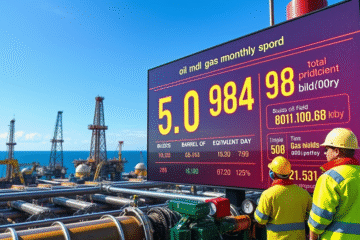OPEC+ Increases Daily Oil Production by 137,000 Barrels
Daily Production of oil has been a crucial topic in the global economic scenario, especially with the recent decision by OPEC+ to increase production by 137 thousand barrels starting in October.
This article will explore the implications of this measure, which is part of a broader strategy to gradually recover 1.65 million barrels per day by next year.
Throughout this text, we will analyze the opinions of cartel members, market conditions, and potential impacts on prices, as well as how this maneuver could benefit the US government in the fight against inflation.
OPEC+ decision on increasing oil production
The recent decision of the OPEC+ to increase oil production in 137 thousand barrels/day from October onwards reflects a strategic move to gradually restore pre-pandemic production.
This increase is part of a broader plan to resume 1.65 million barrels/day until next year.
During a virtual meeting lasting just 11 minutes, key cartel members reached a quick and effective consensus, indicating confidence in the market.
The central objective of the decision is to balance the global market without causing additional pressure on oil prices, which have already fallen by 12% this year.
More details about the decision.
- Additional volume: 137 thousand barrels/day from October
- Recovery pace: Part of a plan 1.65 million barrels/day
- Main reason: Balancing supply and demand without putting pressure on prices
- Estimated duration: See you next year
With this, OPEC+ seeks to ensure a global economic stability, providing a scenario where economic growth and demand resilience can coexist.
Cautious optimism and market conditions
The feeling of cautious optimism permeates OPEC+ members during the recent decision to gradually increase oil production.
This state of mind reflects the sensitivity with which the cartel assesses the global market, while weighing risks and opportunities.
Resilient oil demand, despite a 12% price drop this year, fuels this confidence, offering a solid basis for Saudi Arabia and its allies to consider a strategic production increase, as reported by The Globe.
“We are optimistic but cautious in our judgment, constantly evaluating inventory developments and market volatility,” OPEC+ leaders said.
However, the challenges do not go unnoticed.
A possibility of an oversupply represents a concern, while geopolitical instability remains a critical factor.
The decision to increase production by 137,000 barrels per day from October reflects the group's attempt to reassert its influence without compromising prices.
These factors highlight the complexity of balancing both energy security and economic interests in a constantly changing global landscape.
Challenges in offsetting previous oversupply
OPEC+ faces difficulties in compensation of oversupply previous, a result of past high-production strategies. As the organization seeks to adjust oil production, some members encounter obstacles in rebalancing their quotas.
These challenges stem from the limited capacity of some countries to quickly adjust their production levels and the economic pressure caused by the need to maintain market resilience.
Furthermore, variations in global demand and geopolitical conditions further complicate the scenario.
An illustrative example is Kazakhstan, whose challenge includes not having the same idle capacity as countries like Saudi Arabia or Russia to adapt their production.
OPEC+ has already announced strategies to compensate for overproduction, but countries with less advanced infrastructure have faced financial and technical challenges in implementing these changes.
Therefore, the production increase trajectory may be delayed, especially if oil demand changes abruptly, impacting prices.
This delicate balance reflects the complex dance between supply and demand, where internal and external pressures limit your actions and decisions.
The resumption of production must consider both market expectations and the individual capabilities of each member.
Aim to reduce the idle production safety net
Safety net in the context of OPEC+ refers to idle oil production capacity, which serves as a strategic reserve of barrels of oil that can be quickly activated to mitigate unexpected supply shocks.
This mechanism is essential to stabilize the market in times of geopolitical crises, natural disasters, or any event that abruptly interrupts supply.
Having sufficient idle production ensures that oil prices do not spike, maintaining some predictability in the global energy market.
Currently, OPEC+ is seeking to reduce this safety net by gradually increasing daily oil production.
This decision was discussed and approved with optimism in an 11-minute meeting, as reported by Reuters on OPEC+.
By doing so, OPEC+ aims not only to adjust the market balance but also to respond effectively to any unexpected shock of offer.
This strategy allows the cartel greater flexibility, ensuring that a slight reduction in the idle network does not compromise the ability to respond immediately to future crises.
Context of previous decisions and impact on prices
In 2023, OPEC+ decided to significantly increase oil production, restoring 2.2 million barrels/day between April and September.
This decision was motivated by the need to adjust the market while maintaining price stability.
During this period, oil prices fell by 12%, illustrating the impact of the new production policies implemented.
This drop in prices did not represent a significant downside due to resilient global demand that allowed OPEC+, including Saudi Arabia and its allies, to feel confident in increasing production without negatively impacting the market.
The most recent decisions reflect this confidence gained over the past year.
Among the gradual resumption strategies, a virtual meeting of just eleven minutes was enough to decide on the new addition of 137 thousand barrels per day, continuing the path of carefully calculated increases.
While some members are struggling to adjust past oversupply, this move is seen as part of a larger plan to eliminate spare capacity.
This is expected to please nations seeking lower prices to control inflation.
More details available at Increase in Oil Production in 2023.
| Month | Vol.(bpd) |
|---|---|
| Apr-Sep | 2.2 million |
| 2023 | -12% |
International reactions and expectations
OPEC+'s recent decisions on increasing oil production have generated mixed international reactions.
For the United States, who seek lower prices to contain inflation, this measure brings some relief.
However, even with the increase of 137,000 barrels per day, some analysts believe that the impact on the global oil market may be limited.
Therefore, the expectation is that prices will not fall abruptly.
A link between oil prices and inflation in the United States is indisputable, making it essential for the U.S. government to pursue strategies that maintain some price stability.
On the other hand, producing countries outside OPEC+, such as Canada and Brazil, continue to increase their production, which could bring a balance to global supply.
However, the question remains: will OPEC+ truly be able to control the market without causing major price fluctuations? Only time will tell whether these actions effectively result in a more stable market and whether the US's demands will be met.
In conclusion, the OPEC+ decision reflects a cautious approach in an uncertain market, with the intention of improving the economic situation without causing major fluctuations in prices.
The resilience of demand and the ability to increase production could have significant effects on the global scenario.



0 Comments